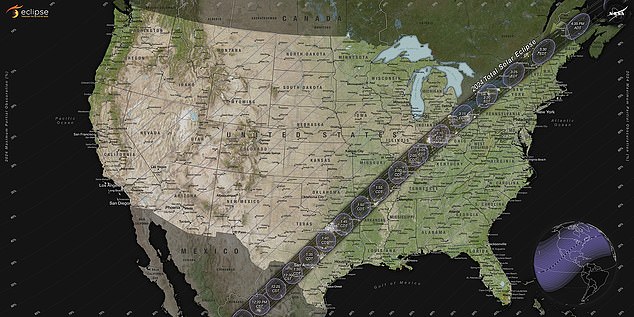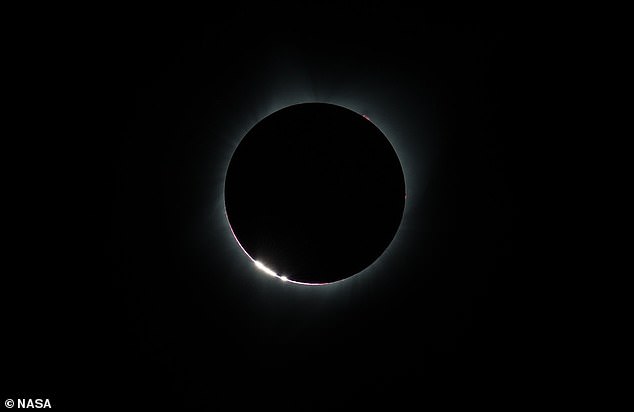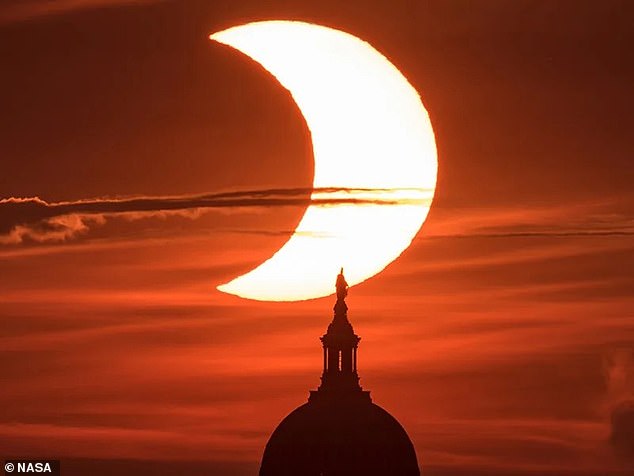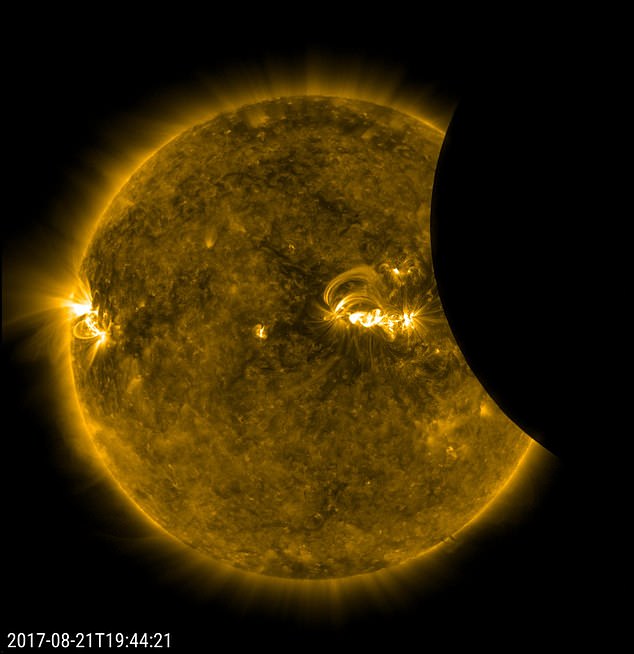Rare solar eclipse is set to become Arkansas’ biggest tourist attraction: Event will last only four minutes – but as many as 1.5 MILLION people will flock to the state in April
A rare solar eclipse will sweep across Arkansas this year and is expected to draw 1.5 million people to the state.
Only two total solar eclipses have passed through the state since it became part of the US after the Louisiana Purchase, the first in 1834 and the second in 1918.
This year’s eclipse will pass northeast from Texarkana to Piggott on April 8 between 1:45 PM and 2:00 PM CDT.
A rare total solar eclipse is expected to draw 1.5 million people to Arkansas this year

The totality zone will fall in the northeastern part of the state from Texarkana to Piggott on April 8 between 1:45 PM and 2:00 PM CDT

The event could temporarily increase Arkansas’ population by 50 percent
Although it looks set to be the biggest tourist attraction this year, it will only be visible for a few minutes at a time.
State tourism director Dalany Thomas told Axios that the event could temporarily increase Arkansas’ population by 50 percent.
The state Department of Transportation expects up to 1.5 million visitors. Half a million Arkansans are expected to travel there as well.
More than 30,000 hotel rooms, 5,400 cabins and 6,400 RV sites are within the eclipse’s path, not including Airbnbs, Thomas said.
Morrilton Mayor Allen Lipsmeyer told public affairs program AR Week that locals should prepare as they would in an “ice storm.”
“You might not be able to get out because of the traffic issues,” Lipsmeyer said.
In anticipation of the influx of travelers, the Department of Transportation has developed a traffic management plan and is working with local agencies.
A total solar eclipse occurs when the moon passes in front of the sun and almost completely obscures it.
While the sun is about 400 times larger in diameter than the moon, the moon is about 400 times closer to Earth, making them appear about the same size in the sky.
During a total solar eclipse, the moon nearly covers the sun, masking everything except the corona – the outermost layer that appears as a ring of light.

Half a million Arkansas residents are also expected to travel into the path of the eclipse

During a total solar eclipse, the moon nearly covers the sun, masking everything but the corona – the outermost layer that appears as a ring of light

The event will be visible in eleven ‘totality cities’, with a maximum viewing time of two to four minutes
The event will be viewable in 11 “totality cities” in Arkansas, with a maximum viewing time of two to four minutes.
Clinton will spend a total of four minutes and 14.9 seconds. The small town is home to riverside walking trails, a historic site filled with local crafts, antiques and restaurants.
The eclipse will cross Mountain View for four minutes and 13.7 seconds. Located deep in the Ozark Mountains, the city is home to the state’s largest craft cooperative, in addition to abundant outdoor recreation opportunities.
Hardy and Cherokee Village are expected to spend a total of 4 minutes, 12.1 seconds. Hardy is a preserved 1920s Ozark village with several bed-and-breakfasts. Cherokee Village, on the other hand, is a 15,000-acre resort destination with two golf courses, swimming pools and a private beach.
In Heber Springs, viewing time is reduced to four minutes and 2.4 seconds. The city serves as a popular access point to Greers Ferry Lake, one of the state’s most popular tourist destinations, and the Little Red River.
Batesville will spend a total of just over 4 minutes. This small community is home to the state’s oldest surviving historic commercial district, but new restaurants and businesses have emerged over the years.
The eclipse will be visible in Mountain Home for less than 4 minutes. The city was one of the state’s first retirement regions, with fishing resorts and hotels galore.
Searcy is expected to spend a total of just 2 minutes and 55.7 seconds. The town’s fame is fishing, but there are also climbing opportunities nearby and numerous hiking trails.
The small Ozark Mountain town of Flippin will fall into the path of the whole thing for just two minutes and 49 seconds. The city is located just three miles west of the White River and is surrounded by resort areas.
The eclipse will be visible for 2 minutes and 47 seconds in Yellville, which provides access to Crooked Creek, popular for fishing and camping. The city is also home to the Rush Historic District, a late 19th century zinc mining town.
Visitors can catch a glimpse of the solar eclipse in Jasper during a narrow window of two minutes and 4.2 seconds. If not, there are plenty of opportunities for activities such as caving, mountain biking and horse riding.
